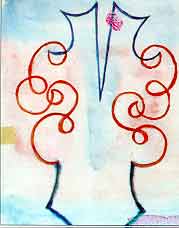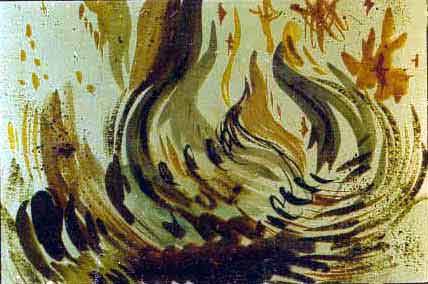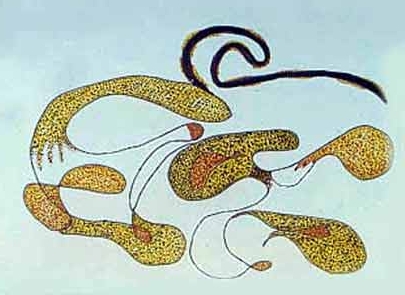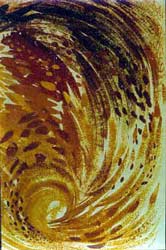ABSTRACT
This article describes experiments held in Kazan, Russia, in
which children "draw" music. The results of the experiments are
considered from educational and psychological points of view.
Visualization of certain characteristics of electrical and
magnetic fields and of mechanical and thermal heterogeneities is
used in scientific research to make the analyzed phenomenon
visual and thereby aid the processes of fixing, observing and
measuring it. The study of acoustics - specifically, musical
acoustics - makes use of this universal and convenient method
as well [1].
Moreover, this method can also be applied in other closely associated
areas - music theory, musical psychology and education.
Experiments with non-instrumental methods of visualizing the
dynamics of different musical characteristics - i.e. visualizations
that are made, so to speak, "by hand," such as those used by
S. Taneyev, G. Konyus and D. Lifschits for the graphic depiction of
volume change, change of melodics, tonal plans, architectonics
and the shape of musical works [2]
- are close to the above-mentioned forms of experimentation. In these
cases the investigators exceeded the bounds of merely physical analysis
and took into account the psychological and aesthetic parameters of
music. More recently, composers of electronic music have found it
necessary to use some form of graphics as a substitute for
conventional music notation, which cannot sufficiently convey
their creative work.
Finally, there is yet another area called "musical graphics,"
which involves methods of painting and drawing music (generally
resulting in abstract visual compositions). These methods were
first used for educational and psychological purposes by 0.Rainer,
an Austrian, who published the results of his experiments
in his book "Musikalische Graphik" [3].
In 1926 he established the Musical Graphics Society and published the
journal "Archiv der Musikalische Graphik" in Vienna. After he died in
1941, his work was continued by G. Zunderman and B. Ernst. In 1962, musical
graphics was introduced into the curriculum of the Vienna Academy
of Music and Fine Art, out of which developed the Musical
Graphics Institute, where a special museum dedicated to the best
works was established. The experience of the institute proves the
effectiveness of drawing music in pedagogical and psychological
research involving audio-visual associations (or concomitant
audio and visual perceptions-a form of synesthesia).
The methods of musical graphics have followers all over the
world. In the Soviet Union, I began regular experiments in this
field in the mid-1970s. The experiments pursued two types of
objectives: scientific (studying the psychological regularities
of color-hearing synesthesia) and pedagogical (testing the
efficiency of the method in education). The scientific objective
necessitated investigating the way music is reflected in
drawings - from distinct musical aspects such as melody, harmony,
mode, timbre, tempo, texture and dynamics to a more general
impression of program music and non-program music in different
styles and characters.
The experiments were preceded by questionnaires in which children
were queried about the following associations "day of week -
color," "month - color," "figures - color," "vowels - color,"
"senses - color," "timbre - color." The questionnaires revealed
that emotions served an intermediary function in forming
relationships in all these associations, including that of
music-color.
The music drawing itself was done by experimental and control
groups of pupils. In the control group, traditional music
classes, without drawing, were held. In the experimental group,
the same musical works were studied but with the application of
the method of musical graphics. The children had a preliminary
acquaintance with the general aspects of music such as melody,
harmony, tempo, etc. and aspects of painting such as drawing,
coloring, composition, etc. The children were asked to listen
intently to a piece of music, then they participated actively in
an analysis of its structure and content. Only after that did the
children begin to draw.
The groups consisted of schoolchildren in grades 1 to 10 in
general education schools, music schools and art schools. The
time spent listening to music was 15 minutes for the general
education students and 60 minutes for the students in the special
schools. Each stage of the experiment was accompanied by concrete
tasks devised according to a principle of proceeding from the
easy to the complicated. For instance, concerning form and
content, the children were first asked to draw an easy-to-perceive
short musical piece, then two one-part program music pieces that
were more complex and, finally, two complex non-program
compositions in two- or three-part form. A large-scale experiment
was held to reveal timbrecolor analogies by means of drawing
music that was written for various solo instruments such as
violin, flute, clavacin and trumpet, and for various types of
orchestras (see Figs 1-4 and Color Plate A No.3).
 |
|
 |
| Fig. 1. Musical graphics by 13-year-old schoolboy;
music by R. Schumann: "Noble Waltz" from the Carnaval series. The
plasticity of the lines fixes the vertical movements of waltz music. |
|
Fig. 2. Musical graphics by a 17-year-old schoolgirl;
music by A. Scriabin: Dark Flame. The student was asked to listen to
the music without knowing the name of the piece. However, she was able
to show the essence of this piano piece through both lines and colors. |
 |
|
 |
| Fig. 3. Student's musical graphics of music by G.Sviridov:
"Romance" from the Snowstorm series. The light, lyrical melody resulted
in anthropomorphic forms with bright and clear colors. |
|
Fig. 4. Musical graphics by a 16- year-old schoolboy;
music by G. Bizet and R. Schedrin: "Bolero" from the Carmen Suite. The
fiery vortex of the Spanish dance formed analogous associations with
the music itself. |
One of the experiments included a kinetic light-music film (a
sort of animated "musical graphics"), which accompanied the music
to be drawn.
All the experiments have proven to have great pedagogical
effectiveness:
- Music drawing is a creative act that requires independent thinking
and action and helps to create conditions for maximum concentration,
to activate attention and interest, and to solve discipline problems
in the classroom.
- Psychologically, the fostering of independent action in a play
situation makes perception more sensitive and effective.
- A comparative analysis of the results of question sessions, which
were held after the experiments were performed and aimed to investigate
the pupils' understanding of music content, revealed an essential rise
in interest and understanding by students in the experimental groups
as compared with the controls (especially in the experiment that
involved showing the light-music film).
- Long-term experiments provided a means of obtaining proof of a more
thorough and sound knowledge of music in the experimental classes when
follow-up studies were done 5 years later.
- Children's drawings reflecting the form and content of musical works
serve as visual documents that allow one to judge the depth of the music
perception as well as the personal psychological peculiarities of the
schoolchildren themselves. This provided feedback that was not available
by any other means (such as testing, conversation or questioning) - in
every class and for every pupil.
The children's drawings themselves, beyond their usefulness in an
educational setting, are of interest as independent works. For that reason
they were exhibited at "Children Draw Music" exhibitions held during
"Light and Music" All-Union Conferences in 1975 (Fig. 5), 1979 and 1986
and at the "Light and Music" festival
of 1987 [4].
They have attracted the interest of specialists in the field of music
psychology because of the way in which they realize dynamic music
perception process compression in simultaneous integral patterns. The
experiments have also confirmed our scientific assumptions about the
regularities of color-hearing synesthesia. We have established hearing-visual
correlations such as melody-drawing,timbre-color, register-lightness
and tonality-coloring.
 |
| Fig. 5. Display of schoolchildren's artwork during the first "Children Draw
Music" exhibition (Kazan, USSR, 1975). |
What are the relationships between the results of these experiments with
drawing music and the other physical methods of visualizing music? They seem
very similar to relationships between psychology and musical acoustics and
between audio perception processes and the physics of sound processes. The
structure and hierarchy of these relationships in synesthesia are the subject
of complex research reported in a monograph by
B.M. Galeyev [5]
and several works of my own [6-9].
References
- See Bulat M. Galeyev. "Sound Visualization
Techniques and Light-Music", Materials on the 3rd All-Union Conference
"Light and Music" (Kazan, USSR: 1975), pp.187-190 [in Russian].
- D.S. Lifschits. Music and Mathematics
(Alma-Ata, USSR: Kazakhstan Publishers, 1976), p.79 [in Russian].
- O. Rainer. Musikalische Graphik (Vienna,
Leipzig, New York: Deutscher Verlag fur Jugend and Volk, 1926), p.185.
- Bulat M. Galeyev. "The All-Union School-Festival
'Light and Music' (Kazan, 20-30 September 1987)," Leonardo 23, No.1,
pp.134-136 (1990).
- Bulat M. Galeyev. Man, Art and Technology
(The Problem of Synesthesia in Art) (Kazan, USSR: Kazan State Univ.
Publishers, 1987) [in Russian].
- Irina L. Vanechkina. "Soviet Musicians and
Light-Music," in The Art of Luminous Sounds (Kazan, USSR: KAI Press,
1973), pp.89-110 [in Russian].
- Irina L. Vanechkina et al.. "Musical
Graphics in Kazan Schools", in The Synthesis of Arts in the Age of
Scientific and Technological Revolution (Kazan, USSR: KAI Press,
1987), pp.153-154 [in Russian].
- Irina L. Vanechkina. "Experiments of 'Musical
Graphics' Abroad", in Functional Light-Music in Production, Medicine
and Pedagogy: Republican Scientific and Practical Seminar collected
seminar papers (Kazan, USSR: KAI Press, 1988), pp.66-68 [in Russian].
- Irina L. Vanechkina and Bulat M. Galeyev.
"'Musical Graphics' as an Effective Method of Musical Education," in
Professional Training of the Teachers of Music (Kazan, USSR: Kazan
Pedagogical Institute Press, 1991), pp.113-127 [in Russian].
Published in "Leonardo", 1994, Vol. 27,
No. 5, pp.437-439.




